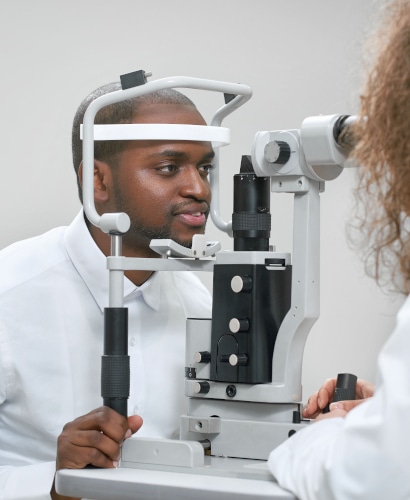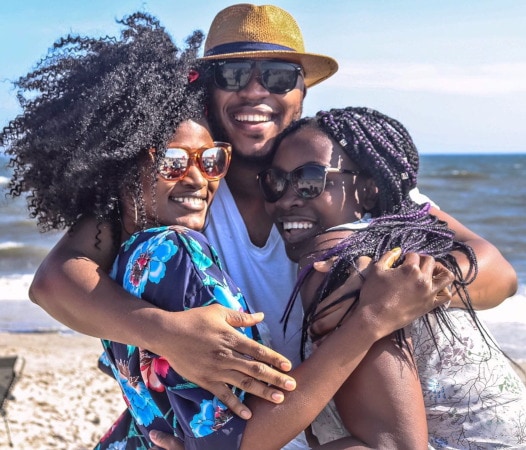Glaucoma affects nearly 67 million patients worldwide. This disease causes vision loss due to high intraocular pressure (pressure in the eye). African Americans are five times more likely to get glaucoma, and — according to a new study — six times more likely to experience blindness from glaucoma.
Glaucoma is already the leading cause of blindness in the US, with primary open angle glaucoma being the most common type. Built-up pressure in the eye causes damage to the optic nerve — the nerve that carries images from your retina to your brain — and leads to vision loss. This pressure build-up can be from either slowed drainage of eye fluids or too much fluid being produced.
Because glaucoma often isn’t noticed until it has progressed to the point of irreversible vision loss, early testing and detection are essential to prevent permanent vision loss.

Risk factors for those of African descent
Glaucoma is the second leading cause of blindness in African Americans. Unfortunately, they are also genetically more likely to have the disease and more likely to develop it earlier than white patients. Knowing the risk factors is vital to preventing vision loss.
Risk factors aside from ethnicity include:
- Being over the age of 40
- Hypertension
- Diabetes
- Drastic nearsightedness
- Steroid use
- Family history of glaucoma
It is still unknown why patients of African descent are at higher risk of glaucoma and related vision loss.
African American glaucoma patients are six times more likely to have vision loss
In a study recently published by the New York Eye and Ear Infirmary of Mount Sinai, researchers discovered that African American patients are six times more likely to experience advanced vision loss from glaucoma.
The results showed a two-fold increase in early vision loss among African Americans. Those patients also had a 6-fold risk for advanced vision loss. Not only were their chances higher, but they also experienced symptoms much earlier.
The African Americans who participated in the study began having vision loss 10-20 years earlier than participants of other ethnicities. While reversing the damage is not possible, controlling the disease is — making earlier screening for glaucoma essential.
Testing for glaucoma
Glaucoma testing for those of African descent should begin around the age of 35 — as their disease symptoms start much sooner. It can be challenging to detect, so several tests exist to evaluate eye health. The main tests for glaucoma include tonometry and ophthalmoscopy. It may be necessary to perform other screenings as well.

Tonometry
This test looks at the inner pressure of the eye. The eye will need to be numb as the doctor places a tonometer gently on the eye to measure the pressure within. It is essential not to rely on this test alone in making medical decisions, so ophthalmoscopy is also recommended.
Ophthalmoscopy
This exam requires the eye be dilated so the doctor can see through the pupil to the back of the eye. You’ve probably had this test performed at a routine visit to the optometrist. With this test, the doctor observes the retina, blood vessels, and optic disc. If either ophthalmoscopy or tonometry shows issues, further testing is necessary to determine if glaucoma is the proper diagnosis.
Perimetry
This test essentially maps out your vision. The doctor moves a light around in your peripheral vision while you look straight ahead. This exam will help your doctor determine where vision loss has occurred. Testing for glaucoma is not just about what you see but also what the doctor can physically see in your eye.
Gonioscopy and pachymetry
These tests look at the physical aspects of your eye to further evaluate your eye health. Gonioscopy requires the eye to be numb, while the doctor uses a tiny mirror to determine the angle at which the cornea meets the iris. Pachymetry looks at the eye itself as well but does not need numbing.
Pachymetry is a simple test that measures the thickness of your cornea. The thickness can affect the pressure reading, so the doctor will use these measurements to help interpret the internal pressure reading test. The ophthalmologist will use the results to determine the best treatment plan for each patient.

Glaucoma treatment
Curing glaucoma is impossible, but we can slow its progression and prevent vision loss. Early testing can help diagnose glaucoma before symptoms begin and allow for preventative measures.
Treatment among those of African descent does not differ from anyone else. The main goal is to lower internal eye pressure and prevent further damage. The treatment plan will be different for each person as the course of action will be based on the patient’s individual needs and disease progression.
Ophthalmologists can help slow down the progression of the disease through medication or laser eye surgery. When these steps are not enough, conventional microsurgery may be necessary. They use these measures to help the fluid flow correctly and reduce pressure while preserving the patient’s vision. It is impossible to cure glaucoma, but there are steps you can take on your own to lessen your risk factors for the disease.
How to prevent glaucoma
Lifestyle changes can help prevent further damage from glaucoma. Aerobic exercise and yoga have been found to be beneficial in lowering eye pressure.
Aerobics can lower the pressure within the eye and increase the blood flow to the eyes and brain. Since the increase in pressure causes glaucoma, the benefits of aerobic exercise can be substantial.
Yoga is another exercise program that can be beneficial. Tratak kriya is a specific yoga exercise geared towards alleviating eye pressure. Although yoga has many benefits, all activities that include inversions should be avoided as they can increase eye pressure. Always talk with your doctor before beginning any exercise program.
Start screening for glaucoma early!
In light of recent findings, those of African descent are more likely to have not only glaucoma but also substantial vision loss associated with the disease. Early detection is vital. A combination of diet, exercise, and medical treatment can give you the best chances for success in slowing down the progression of the disease and protecting your vision.
Assil Gaur Eye Institute: The best glaucoma specialists in Los Angeles
The team of experts at AGEI includes eye doctors, surgeons, and technicians who are all committed to improving their patient’s holistic health.
We specialize in highly innovative surgeries that can halt many eye conditions typical of older adults, such as cataracts, glaucoma, retinal detachments, and myopia. We also provide routine eye exams and are happy to work with your family doctor to ensure a welcoming and thorough health care plan.
Please call 866-945-2745 or make an appointment online. At Assil Gaur Eye Institute we take our patients’ safety seriously. Our facility’s Covid-19 patient safety procedures exceed all CDC recommendations to minimize the spread of the coronavirus. Masks are required in our institutes at all times.
We are conveniently located for patients throughout Southern California and the Los Angeles area at locations in or near Beverly Hills, Santa Monica, West Los Angeles, West Hollywood, Culver City, Hollywood, Venice, Marina del Rey, Malibu, Manhattan Beach, and Downtown Los Angeles.
- What’s New in Keratoconus Treatment? A 2024 Update - 04/16/2024
- Dr. Assil and His Team Correct the Side Effects of Laser Eye Surgery - 04/03/2024
- What is ocular herpes? - 09/22/2023













